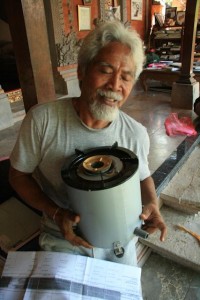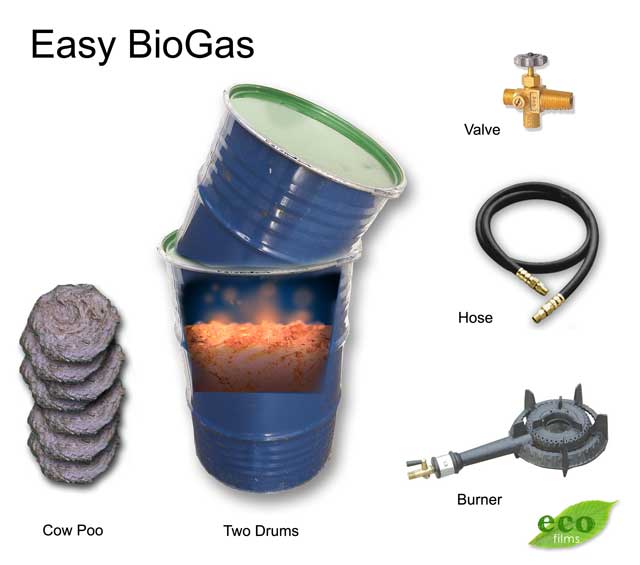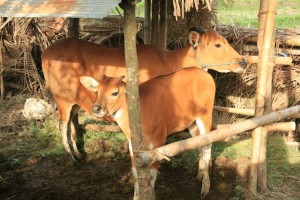Make Your Own Biogas!
If you thought making your own biogas for cooking was rocket science stuff and you needed a laboratory of technical wizardry to do it yourself then this guide will show you how easy it is to make your own Biogas plant.
A family of four can be quite self sufficient when it comes to cooking an evening meal provided however you have access to a couple of dairy cows to supply the fuel.

Mr Nomad with Gas Burner
This is really a part two story about Nomad of Bali.
When we interviewed him for a story on his organic garden he started telling us about his other big plan, a dream to be totally self sufficient in all his energy needs.
We thought maybe his ambitions were a little fanciful and unrealistically high but when he told us he had already built a biogas production facility on his other farm and that he had already harnessed all his herd of cattle and that it wasn’t a silly dream but a working prototype – then we wanted to know more.
How hard is it for an average family to build such a system? According to Nomad – its easier than you think. There are various plans to suit your own needs. If you want to do super cheap then here’s the guide to do it on a shoestring. Put it to the test. If it works – scale this up to match your dreams.
METHANE GAS
When animal manure or plant materials rot – they give off methane gas. Your job is to collect this gas and store it and use it for cooking the evening meal. Before we start, a word about Biogas and cold climates. Biogas is best produced at a temperature between 32 and 37 degrees C. When the temperature drops below 15 degrees C almost no gas is made. So if you live in a cold climate country – take a deep breath – these instructions will probably be of no use to you! But if you still want to persist – bury the biogas drum underground. Hopefully that will raise the temperature a bit.

The fist thing you’ll need to get is lots of cow manure. A cow is a big methane producer so lets harness all that gas and put it to good use. You’ll need two drums. A large drum and a slightly smaller drum that can slide into the bigger drum. Any sort of drum will do as long as they are reasonably air tight and will be able to store a large amount of cow manure mixed with water to create a thick slurry. An empty drum will need to be placed over the first drum with the slurry and pushed down to the base of the larger drum. This drum will trap all the methane gas and store it for your burner. As the gas is created it may lift your smaller drum up on an angle slightly. This is a good sign letting you know that methane gas is being created. You will need a valve of some sort to regulate the flow of gas into your airline and then onto your burner.

What waste material is suitable?
Any animal manure. Sheep, pig, cow, goat and chicken manure is all suitable. So is crop and plant waste. Straw that is mixed with manure is also suitable. Just make sure the mixture is chopped finely to allow it to mix easily. Use one bucket of water for every bucket of manure. Stir well. You really want the consistency to resemble a thick slurry. A good way to check for leaks in your tank is to put soapy water on the small drum where the gas line will exit the tank. Use tar, mastic or thick paint to seal any gas that is escaping.
Now a word of caution. It may take up to three weeks or even a month before the biogas is ready to use. Some people advocate making a starter biogas system that you just add manure to the system on a regular basis to keep the thing running smoothly. But you will need to be patient before the system is ready to be used the first time you make this system.
Once running however, there should be enough gas to cook a regular meal each night for a small family. The gas in the drums will keep on producing for a further six to eight weeks before the system slows right down. During those weeks, half the gas will be made in the first two or three weeks (depending on your outside weather temperatures) and the rest of the gas will be produced over the last five or six weeks.
Cold Weather Biogas
If the temperature falls below 15 C degrees where you live, consider burying the larger drum containing the manure slurry underground and piling a lot of mulch around it to form a sort of a compost tower to keep the temperature inside the drum reasonably stable.
Problems with Biogas
Sometimes a layer of scum can form on the surface of your waste mixture. If this happens, less gas may bubble to the surface. Remove the scum or give your mixture a good stir to keep it producing the gas. Do not lift the smaller drum to inspect the system or any gas already made will escape! If the waste is well mixed before it is put into the container at the start, then there is less chance of the scum forming. Probably best to stick with animal manure in the mix rather than too much plant material. A thick mix will also have problems. Add more water and stir.
When Gas is created
A few days after the small drum rises to the surface, open the valve and test. Some air will be mixed with the gas. This will create a kind of spluttering gas. Let some of this gas escape. Then close the valve. If you have done this correctly, the new gas made will be stable and be safe to burn. Do not open the drum unit again until all the gas is used up. After six or eight weeks, dismantle the system. Keep some of the old slurry as starter fertilizer for your next load. 4 litres of manure slurry will be ample to be reused again when you make a fresh load. Your next attempt will take less time.








Recent Comments